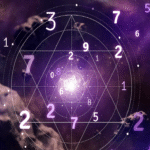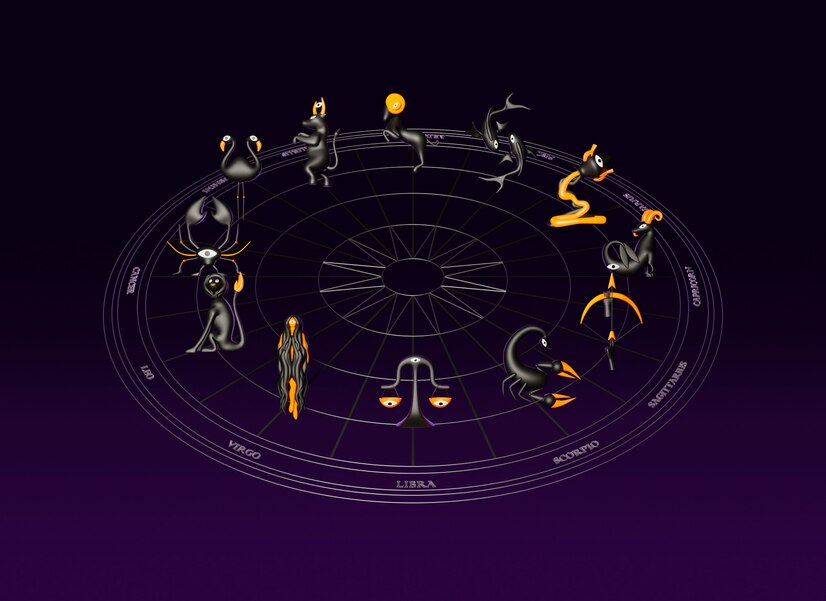Welcome to the Cosmic Map: The Shadow Planets’ Path
Embark on one of the most profound and uniquely Vedic journeys as we explore Rahu (North Node) and Ketu (South Node), the Chhaya Grahas or shadow planets. Unlike physical bodies, these are mathematically calculated points where the Moon’s orbit intersects the ecliptic (the Sun’s apparent path). In Jyotish (Vedic Astrology), Rahu and Ketu are considered full-fledged Grahas with immense karmic significance, representing the axis of destiny, obsession, detachment, past lives, and future lessons. This guide illuminates the Nodes of the Moon (Rahu & Ketu) in Astrology from a Jyotish perspective.
First Stop: The Traditional Foundations of Rahu & Ketu
(The Traditional Jyotishi’s View)
Our journey begins with the Puranic myths and classical Jyotish texts where Rahu and Ketu originate from the celestial churning, representing the immortal head (Rahu) and body (Ketu) of the demon Svarbhanu, forever chasing Surya (Sun) and Chandra (Moon), causing eclipses.
- Historical Context: Rahu and Ketu are treated as powerful malefics (Papak Grahas) in traditional Jyotish. They indicate areas of intense karmic focus, often linked to unresolved issues from past lives. Their influence is considered powerful, often sudden, and sometimes disruptive.
- Classical Techniques:
- Calculation: Nodes are calculated mathematically (Mean vs. True Node positions are debated, Mean Nodes often preferred traditionally). They always move retrograde (backward) through the zodiac.
- Significations:
- Rahu (North Node): Represents worldly desires, obsessions, ambition, foreigners/foreign lands, technology, amplification, illusion (Maya), poison, unconventionality, future karma focus.
- Ketu (South Node): Represents past life skills/attachments, detachment (vairagya), spirituality, liberation (Moksha Karaka), intuition, confusion, loss, endings, headless action, subtle perception.
- Placement: Their placement by Rashi (sign) and Bhava (house) indicates the primary areas of karmic focus, desire, and necessary detachment in this life. They strongly influence the houses they occupy and the planets they conjunct.
- Aspects (Drishti): Traditionally debated. Some authorities assign no aspects. Others grant them aspects similar to Jupiter (5, 7, 9) or Saturn (3, 7, 10). Conjunctions and oppositions are always potent.
- Eclipse Points: They mark the points where solar and lunar eclipses can occur, amplifying their sensitive nature.
- Traditional Interpretations: Rahu tends to amplify the house/sign it’s in, creating intense desire or ambition related to its themes, potentially leading to obsession or illusion. Ketu tends to create detachment, confusion, dissatisfaction, or sudden breaks related to the house/sign it’s in, pushing towards inner reflection or spiritual seeking. They give results similar to their dispositor (lord of the sign they occupy) or planets they associate with.
- Expert Insight (Traditional Source): “Rahu acts like Shani (Saturn), Ketu acts like Mangal (Mars). They amplify the houses they occupy and planets they join, bringing forth karmic results with suddenness and intensity.” – Paraphrased principle from Brihat Parashara Hora Shastra.
- Hidden Wisdom: Kala Sarpa/Amrita Yoga: When all 7 visible Grahas are hemmed between Rahu and Ketu (moving towards Rahu = Kala Sarpa; towards Ketu = Kala Amrita), it forms a powerful yoga indicating a life intensely focused along the nodal axis, often involving significant struggles but also potential for great achievement or spiritual growth.

Crossing the Bridge: Where Karma Meets Psychology
As we journey forward, the understanding of Rahu and Ketu expands to encompass their profound psychological impact. The karmic axis they form is seen as a core psychological dynamic – the tension between past-life tendencies/detachments (Ketu) and present-life desires/obsessions/growth areas (Rahu). They represent the evolutionary pull of the soul.
Second Stop: The Contemporary Interpretation Landscape
(The Modern Jyotishi’s Approach)
Here, Rahu and Ketu are explored as key indicators of our deepest psychological patterns, karmic lessons, and soul purpose within the Jyotish framework.
- Contemporary Methods: Modern Jyotishis deeply analyze the Rahu-Ketu axis by house and sign placement. The house containing Ketu shows areas where we have mastery from the past but need to detach from; the house containing Rahu shows areas of intense desire, fascination, potential obsession, and where major life lessons and growth lie in this incarnation.
- Psychological Insights (Vedic Lens): Rahu represents the ‘foreign’ element within the psyche – areas where we feel driven, perhaps compulsively, towards experiences that are unfamiliar or destabilizing, ultimately forcing growth. Ketu represents where we feel ‘headless’ or detached, relying on past patterns, sometimes leading to dissatisfaction or a spiritual void prompting the Rahu quest. Their interplay describes a fundamental life tension.
- Evolving Interpretations: Rahu’s connection to technology, mass media, and global trends is increasingly emphasized. Ketu’s link to intuition, psychic phenomena, and spiritual paths like meditation or renunciation is explored more deeply. The psychological impact of Kala Sarpa Yoga is examined in terms of feeling ‘fated’ or needing to break karmic patterns.
- Technique Deep Dive: Nakshatra Placement of Rahu/Ketu: Analyzing the specific Nakshatras occupied by Rahu and Ketu provides extremely detailed insights into the precise nature of the desires, obsessions, past skills, and detachments involved in the karmic axis. This is crucial for nuanced interpretation.
- Expert Insight (Modern Jyotishi): “The Rahu-Ketu axis is the dragon of desire and detachment within your chart. Understanding where Rahu pulls you and where Ketu asks you to let go is fundamental to navigating your karmic path and finding balance in this lifetime.” – Contemporary Jyotish Practitioner.
- Alternative Approaches: Exploring the nodes’ connections to collective karma, ancestral patterns, or specific psychological complexes like addiction (Rahu) or dissociation (Ketu).

Third Stop: The Student’s Learning Curve
(The Student’s Journey)
Grasping the abstract nature of Rahu and Ketu (as non-physical points) and their profound karmic significance is a major step for Jyotish students. Memorizing their complex significations and understanding their axis effect is key.
- Learning Process: Students learn the glyphs and core meanings: Rahu (desire, amplification, unconventionality) and Ketu (detachment, past, spirituality). Understanding they always operate 180 degrees apart as an axis is fundamental. Learning which themes belong to which node and how they interact across opposing houses takes practice. The debate around their aspects (Drishti) adds complexity.
- Common Questions: “Are Rahu and Ketu always bad?” Answer: No. While classified as natural malefics due to their potential for disruption and illusion (Rahu) or loss/confusion (Ketu), they are essential karmic catalysts. Their outcomes depend entirely on their placement (sign/house), dispositor’s strength, associations, and the overall chart. They can bestow immense worldly success (Rahu) or profound spiritual insight (Ketu) under favourable conditions. “Which node calculation should I use (Mean or True)?” Answer: Both are used; Mean Nodes are more common traditionally. Consistency is key. Software usually allows selection.
- Breakthrough Moments: Understanding the Rahu/Ketu axis in one’s own chart – seeing the pull between the houses they occupy – is often a profound moment of self-recognition. Identifying the themes of the current Rahu or Ketu Dasha/Antardasha and seeing them play out is another significant learning experience.
- Expert Insight (Jyotish Student): “Learning Rahu and Ketu felt like unlocking the ‘why’ behind my biggest cravings and my strangest dissatisfactions. Seeing them as an axis connecting my past patterns (Ketu) to my current life lessons (Rahu) made so much sense.”
- Misconceptions vs. Reality: Misconception: Rahu only brings worldly success, Ketu only spirituality. Reality: Rahu’s desires can be spiritual; Ketu’s detachment can manifest negatively as apathy or confusion. Their expression is highly contextual. Misconception: Kala Sarpa Yoga is always a curse. Reality: It indicates an intense life focus and can bring significant challenges, but also immense strength and unique achievements if the chart lords are strong.
Fourth Stop: The Realm of Practical Application
(The Practical Application Expert’s Guidance)
Practical Jyotish heavily relies on Rahu/Ketu analysis for understanding deep-seated karmic patterns, obsessions, areas of hidden talent, spiritual potential, and timing major life shifts.
- Real-World Usage: Analyzing the Rahu-Ketu axis helps clients understand core life lessons, recurring patterns in relationships or career, areas of compulsive behaviour, innate talents (Ketu) vs. areas needing development (Rahu). Dasha periods of Rahu and Ketu (lasting 18 and 7 years respectively in Vimshottari) are known for bringing significant, often unexpected, changes and karmic reckonings. Upayas for Rahu/Ketu are often prescribed for challenges.
- Client Experiences: Clients often experience major breakthroughs understanding the source of persistent desires (Rahu) or feelings of alienation/detachment (Ketu). Nodal analysis helps make sense of seemingly irrational patterns or intense life periods.
- Practical Tips:
- Identify the houses occupied by Rahu and Ketu in your chart – this is your primary karmic axis. Meditate on the themes of these houses.
- Note the sign lord (dispositor) of Rahu and Ketu – their strength and placement heavily influence how the nodes operate.
- Be especially mindful during Rahu and Ketu Dasha/Antardasha periods and transits over sensitive natal points.
- For Rahu challenges (obsession, illusion), consider remedies like chanting Rahu mantras (Om Rahave Namah), donating Rahu-related items (e.g., Hessonite, black sesame seeds) on Saturdays.
- For Ketu challenges (confusion, detachment, loss), consider remedies like chanting Ketu mantras (Om Ketave Namah), donating Ketu-related items (e.g., Cat’s Eye, blankets), or engaging in spiritual/charitable activities. Always consult a professional for personalized advice.
- Technique Deep Dive: Nodes in Vargas: Analyzing Rahu/Ketu placements in divisional charts (like D9 Navamsa for overall dharma/relationships, D10 Dasamsa for career) reveals how the karmic axis influences specific life areas.
- Expert Insight (Jyotish Consultant): “Rahu and Ketu hold the keys to the soul’s evolutionary journey in this lifetime. Analyzing their axis reveals the karmic script – the baggage we carry (Ketu) and the lessons we’re driven to learn (Rahu). Guiding clients through their nodal placements is core to my practice.”

Journey’s End: Your Personal Practice Path (Embracing the Axis)
You have journeyed through the shadowy, powerful, and profoundly revealing landscape of Rahu and Ketu in Jyotish. From their mythological origins and traditional interpretations to their psychological depth, learning challenges, and crucial practical applications, the nodes are central to understanding your karmic path. Integrating these perspectives means respecting their power (Traditional), understanding their psychological pull (Contemporary), mastering their interpretation (Student), and consciously navigating their lessons (Practical). The Nodes of the Moon (Rahu & Ketu) in Astrology form the spine of your karmic story; embrace the axis, understand its tension, and walk your path with awareness.
Map for Further Exploration (Further Learning)
- The Significance of Bhavas (Houses) in Jyotish (Detailed analysis of houses occupied by Rahu/Ketu)
- Introduction to Nakshatras (Rahu/Ketu Nakshatra placements are crucial)
- Understanding Dasha Systems in Vedic Astrology (esp. Rahu and Ketu Dashas)
- Kala Sarpa Yoga and other Nakshatra-related Yogas
- Upayas (Remedial Measures) for Rahu and Ketu









